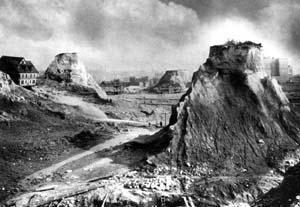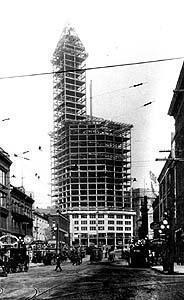

This story ran in The Seattle Times on March 17, 1996
By Sharon Boswell
and Lorraine McConaghy
Special to The Times

In this desolate 1910 scene
looking south from Bell Street across Fourth Avenue,
few of what were jokingly referred to as "spite mounds" remain of what was once Denny Hill.
Photo Credit: Asahel Curtis / UW Special Collections
SEATTLE HAD BIG DREAMS.The famed Seattle Spirit provided the money,
muscle and moxie for the city's remarkable transformation from boomtown to metropolis;
it also encouraged dreamers -- mostly visionaries and a few schemers -- who had even grander
ideas for the future.
From building skyscrapers to drilling tunnels, cutting away hillsides
or bridging the lakes, their great notions soon changed the entire cityscape.
Seattle was not alone in its ambitions, as colossal engineering projects
like the Panama Canal gave the world notice of America's tremendous technological capabilities and
"can do" spirit. But on a regional scale, the city's projects were equally grandiose,
if not occasionally outrageous.
Why not dig a ship canal from Elliott Bay to Lake Washington,
fill in the lower half of Lake Union for more industrial space or build a giant
commuter tunnel under First Hill? And while we're at it, why not even get rid of all
those hills blocking the city's growth?
As taxpayers and politicians fought over how much it would cost,
planners and builders forged ahead to redesign the city. Leading the way was R.H.
Thomson, the intense city engineer who oversaw all municipal construction --
from sewers and sidewalks to bridges and public buildings. A technical man with a streak of
imagination, he let no natural obstacle stand in the way of completing
the infrastructure of a great city.

1911. Construction
of L.C. Smith's 42-story tower at Second Avenue and
Yesler Way begins after the City Council lifts height restrictions.
Photo Credit: Seattle Times
TENACIOUS AND INFLEXIBLE, HIS DISDAIN for those who did not share
his vision also made him many enemies.
Thomson's work had always generated controversy.
Back when Seattle needed a reliable water supply, Thomson had advocated and
successfully carried out an ambitious plan to run a pipeline nearly 30 miles
from the Cedar River. His insistence on municipal ownership of this water system,
as well as lighting and power plants, pitted Thomson against businessmen
who wanted private development rights.
But none of his proposals generated more debate than regrading,
the dramatic sculpting of Seattle's hillsides to make the march of progress much less steep.
Earlier regrade projects had leveled First Avenue, filled in parts of Westlake
and excavated sections of more than 28 other downtown streets. But the greatest obstacle
to the city's northward growth was Denny Hill; here Thomson's engineering know-how was put to the test.
Between Pioneer Square and Lenora Street -- a distance of about 12 blocks --
Second Avenue climbed 190 feet, too precipitous for most traffic. And perched atop the hill
was the huge Washington Hotel, a city landmark whose owner, James Moore, initially opposed Thomson's plans.
But the attractions of easier commercial growth and crosstown access persuaded
the city to level Denny Hill. When steam shovels couldn't do the job, huge hydraulic
pumps were brought in. Pointing gigantic water cannons at the hillside,
Thomson's men sluiced nearly 6 million cubic yards of earth into tunnels and
flumes that then dumped it into Elliott Bay.

1908. City Engineer
R.H. Thomson, left, develops the city's infrastructure by building the North Trunk
sewer line and a second Cedar River pipeline.
Photo Credit: Edward Curtis, Rainier Club Coll.
THE MUD AND DISORDER SEEMED ENDLESS. Some applauded Thomson's untiring efforts,
while others, such as The Times, loudly accused him of despotism, even graft. Some property owners
sued to stop the work, but found their homes or businesses left on pinnacles of earth as
the regrading proceeded around them. Even James Moore eventually conceded, and 141 feet were
excavated from his hotel's site; he rebuilt on reconstructed Second Avenue.
By 1910 this phase of the Denny regrade was nearly complete, halting at
Fifth Avenue. Excavation of the eastern half of the hill did not resume until 1929,
although other major thoroughfares, including Jackson and Denny, were totally
transformed between 1907 and 1912.
Once an area was regraded, development could proceed. Competition arose
between regrade entrepreneurs and landowners in the original city center to the south.
An Eastern investor, L.C. Smith, began construction of Seattle's first true skyscraper,
the 42-story Smith Tower, in 1911, revitalizing the Pioneer Square area.
But in that same year citizens were presented with an elaborate proposal
to redesign the entire city, including a new civic and transportation center in the heart
of the Denny regrade.
Developed by noted engineer Virgil Bogue and strongly supported by Thomson,
the Bogue Plan was bold, sweeping and farsighted. As they had during the regrade efforts,
backers assumed that nature should be subdued, no matter what the cost and disruption.
Most Seattle residents, however, were tired of the mess and unwilling to pay the price.
Voters defeated the Bogue Plan in 1912, leaving Seattle to develop slowly, in a more piecemeal
fashion than its overeager planners had dreamed.
Historians Sharon Boswell and Lorraine McConaghy teach at local universities
and do research, writing and oral history. Original newspaper graphics courtesy of the Seattle Public Library.
More photos
Table Topics




Copyright © 1996 The Seattle Times Company


